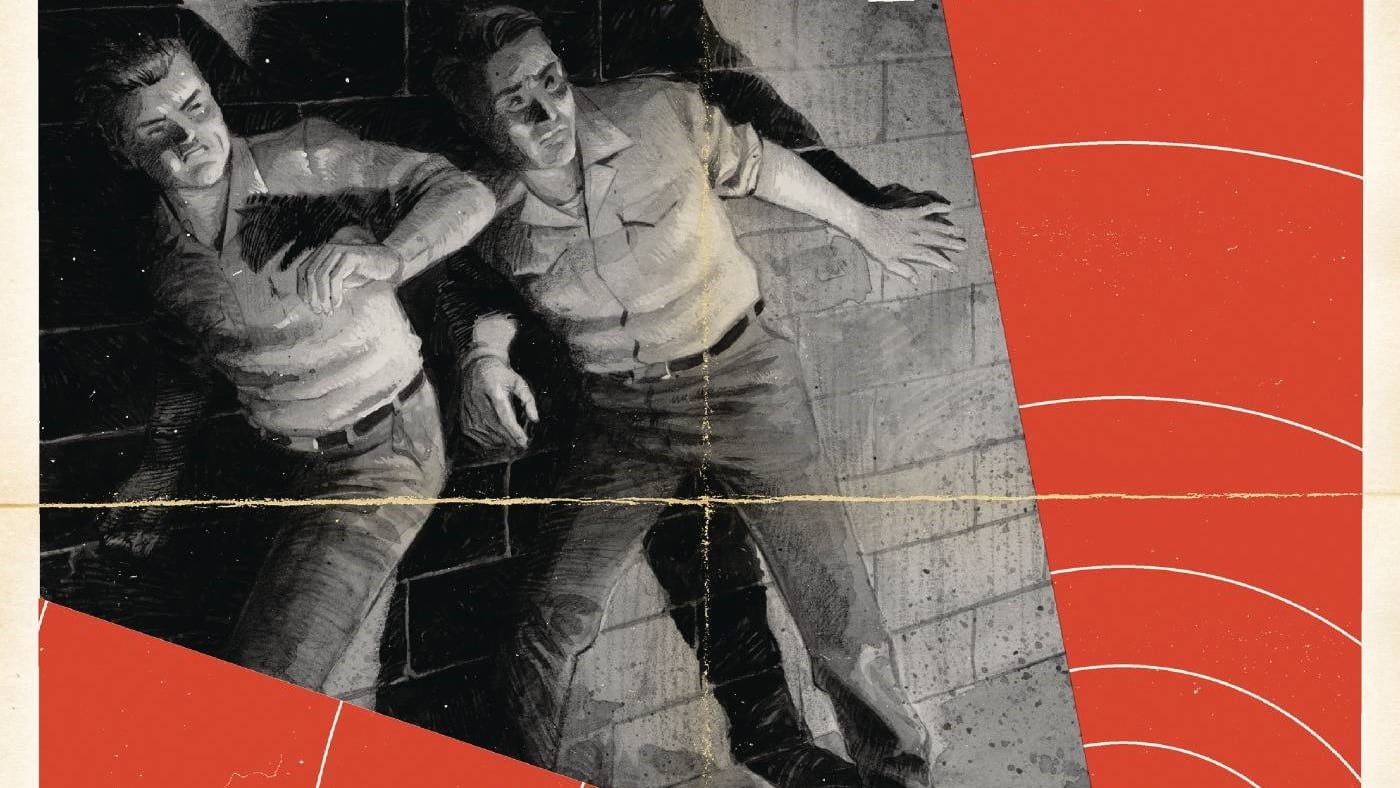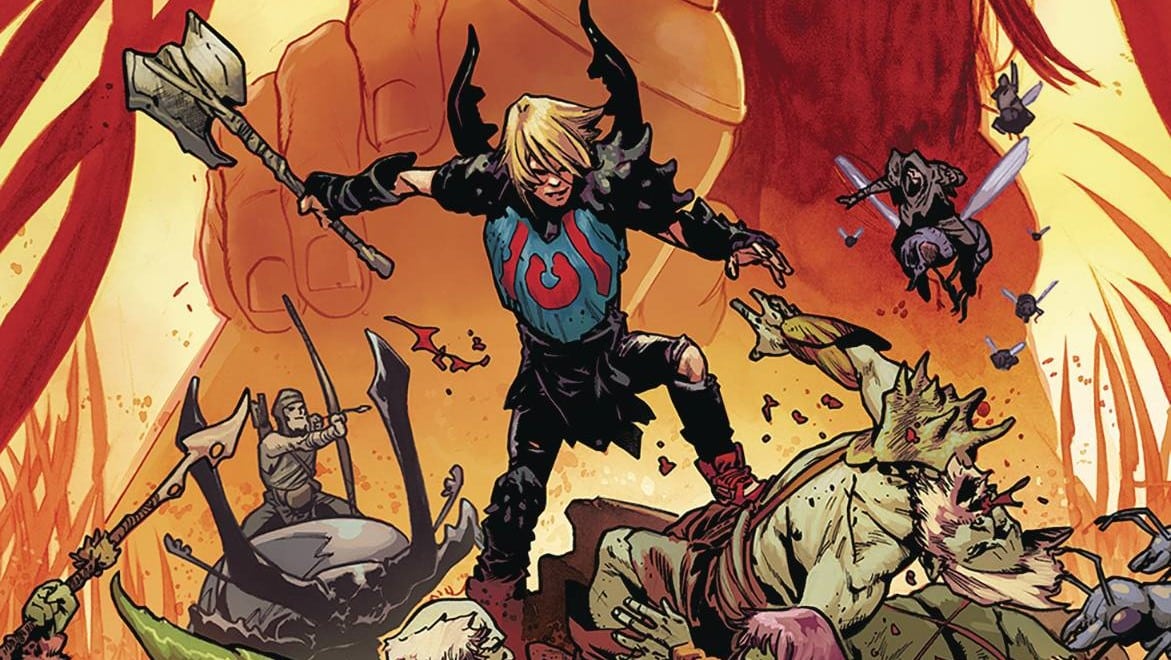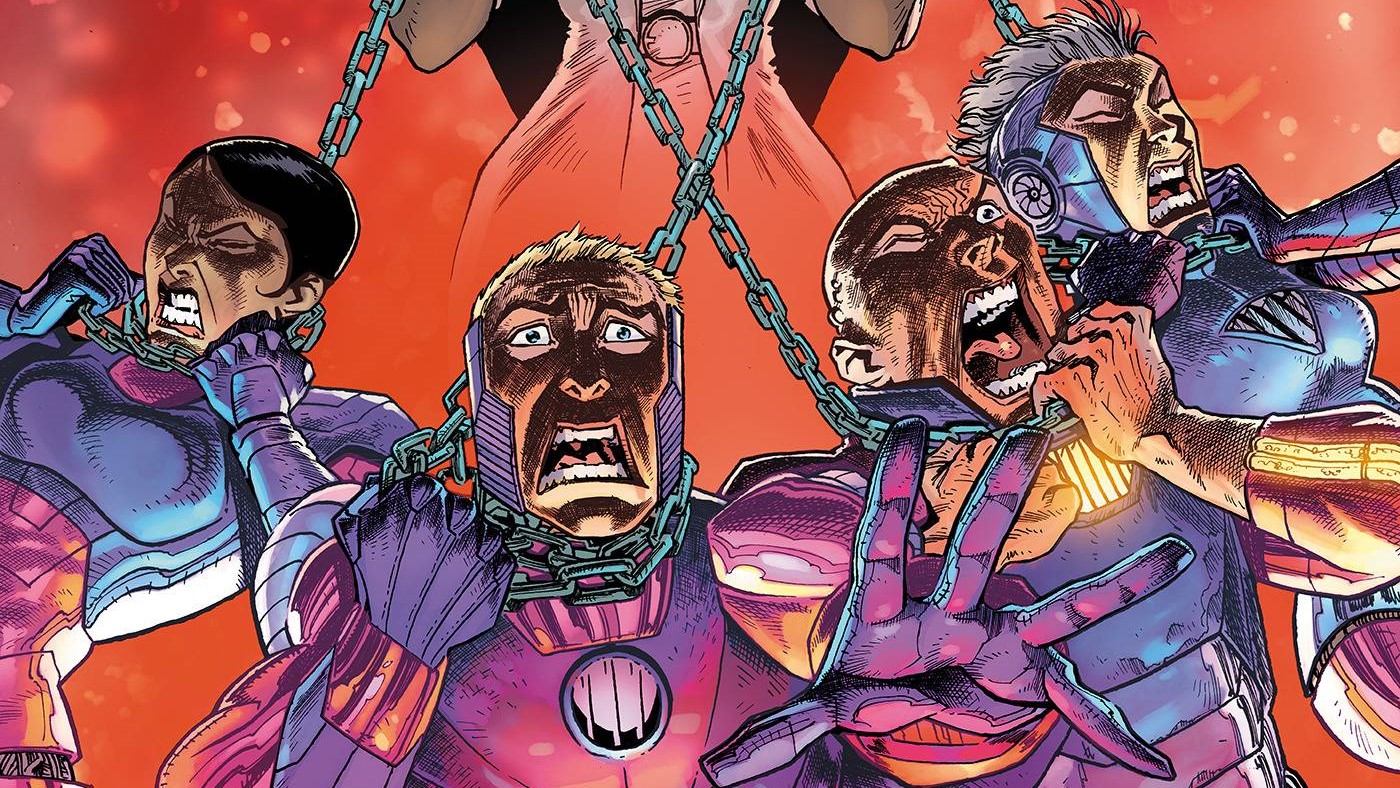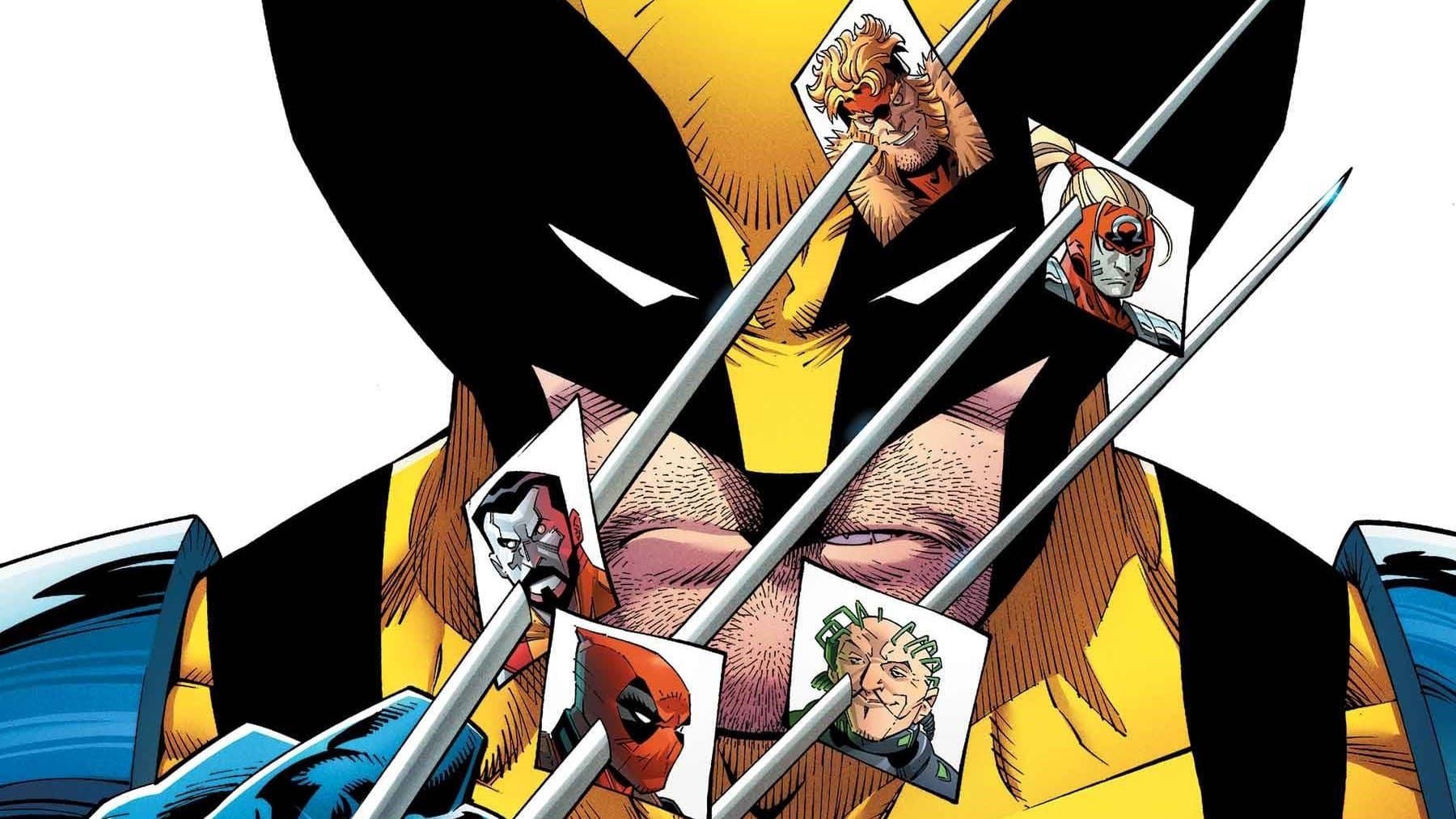A young Cable’s adventure begins in this debut issue by Gerry Duggan, Phil Noto and Joe Sabino. Expect the unexpected in a story with wrestling, swords, and Space Knights.
Ritesh Babu: This is a rather surprising debut. I had no idea as to what this was gonna be like, given Kid Cable is such a new figure and such a departure from the familiar, grizzled, weary older Cable. So there’s a lot of baggage that comes with this, a set of expectations, given what Cable is or has been. And while I’m certainly not as close or familiar to the character the way some are, I was really interested in what direction they were gonna take this. And I have to admit, I’m impressed. This blew me away.
Ian Gregory: I completely agree. Cable has “only” been around for a little over 30 years, but he’s had a lot of (notoriously complex) stories. Kid Cable is both an opportunity for Duggan to give Cable a fresh start, but also a major challenge: how many changes can you make without him becoming a completely different character? Duggan walks a fine line here, and I think manages to establish Kid Cable as both distinct from his older counterpart while still being familiar to long-time fans. Will this issue satisfy the Liefeld-heads who have sworn to hate Kid Cable? I’m not sure that’s possible, but everyone else will have an absolute blast here.
The Bonds Of Cable

IG: I think one of the main ways Duggan distinguishes Cables is through his interactions with the other mutants in this story. Cable has traditionally played a mentor role (first to the New Mutants, then various X-Forces, then Hope) and instead here we have a teen who’s much more of a team player. He’s flirting, helping kids, and being smarmy to his family. I think pairing him with Armor and Pixie is a good idea, as neither of these characters have extensive experiences with Old Cable (except for Armor’s brief, bizarre stint on X-Force, which she mentions here. The less said about Brisson and Malin’s Cable, the better). [Ed. note: Armor teamed up with Longshot, Shatterstar, X-23, and Doop to fight the Externals. It was not great.]
RB: Yeah. And the thing that’s really striking to me is how the book just isn’t bogged down in exposition the way you’d expect, given the nature of its new lead. That was a problem it could’ve very easily run into. Instead, it opens quick and immediately establishes a clear sense of personality by showing you Kid Cable in action and defines him by his relationship to others. He’s a bit of a cocky punk with Logan, he loves to win and boasts about it, he’s a young dude who’s just ready to get this over with, as he wants to get to a date.
IG: Duggan is actually doing a lot of stealth-exposition in just these first few pages. Cable’s mutant powers range from God Tier (Cable & Deadpool) to non-existent (most Cable comics). We see here that Cable’s got powerful TK – enough to hold down a fighting Wolverine – and long-range telepathy, but he’s not so powerful that he’s keeping a city in the sky by himself. He’s also just as resourceful, quickly adapting a broken weapon into a tool to take away Wolverine’s advantage. This is all important information for people familiar with the character, especially since he definitely hasn’t had a major appearance in another comic yet in DoX [Ed. note: please, no corrections]. Even though this Cable is younger, he’s still accustomed to battle.
RB: There’s very much a sense of youthful rebellion here. The Quarry serves as a hilarious wrestling arena; the info-pages are terrific with the details and textures, they add another layer of hilarity to the whole enterprise. There’s also a very Samurai In The Dojo vibe to the Logan scene as he instructs Cable with a sort of performative seriousness, that of a mentor. Cable is no longer the mentor figure, like you mentioned, but the one on the receiving end of said mentorship and the way this Kid Cable responds to that is by smirking, goofing around, serving a role that may once have felt inconceivable for him.
IG: I was worried that Cable might be written as frustratingly edgy and overwrought, as he often is, but Duggan dodges that neatly. He makes Cable’s “See you at home, Uncle Logan” line after their fight both a cute nod at their living arrangements as well as a smug one-liner. This Cable’s got a believable kind of charm, one that carries through the entire book. Cable going on a double-date [Ed. note: That is, a date with two women, not a date with another couple] with Pixie and Armor actually makes sense rather than just being wish-fulfillment. They have fun banter, and work well together when the going gets rough. Cyclops’ arrival at the end of the issue seals the deal – notice how everyone snaps to attention when Krakoa’s commander shows up? This is a Cable who’s not in charge anymore, and has fit easily into life on the island.
RB: And a lot of that, really, comes down to Noto’s work here as well, which is just lovely. This is a great example of a writer just taking great advantage of a terrific artist. When you’ve got Phil Noto, you let him show all you want to convey and so he does. Everything, from the displays of power early on, to the moments during said date and even the Cyclops arrival and the body language there, Noto is able to get all that across really well. One of the most striking things in the book for me is the lovely pinkish-red colors he uses to depict danger and sort of freeze time, letting the readers get a sense of things. It’s not quite the darker red of Armor, it’s this striking rouge that just sticks with you.
But beyond that, the little smirks, the subtle hints and glances, whether it be Logan after taking off his mask or how Noto frames these characters. Both separately and together, you’re shown a great deal. Noto does a lot of the storytelling here, that it can feel almost effortless and invisible in its execution. You really get a sense of these people, Krakoa itself, the familiarity and comfort they have with one another and how they interact. It feels believable and Noto’s a big reason all the relationship stuff works.
IG: I absolutely agree. Noto’s giving this book a great visual identity with these watercolor-style visuals. He nails character expressions, big action scenes, fantastical settings, and background visual gags (shoutout to Wolverine’s cheering squad). Cyclops appearing from the dark of Krakoa, with only the single red line of his visor visible, is a great use of a character’s key symbol and gives him a scolding foreboding that perfectly fits Scott. Not to mention the last page of this issue, which lands with incredible impact and gave me chills. He employs a similar trick here as he did with Cyclops, using a famous silhouette to build anticipation for a character’s appearance.
RB: This is a book that really, really knows how to utilize the iconography it’s got at its disposal. Which brings us to…
The Big Sword

IG: It’s pretty big, and you know it’s powerful because it made me dig out the issues of ROM Space Knight my father gave me. Dawn of X has been pulling all sorts of characters from all parts of X-Men history, but I don’t think a single person was prepared for the Space Knights to make a major appearance. I’m a continuity gremlin, so this delights me, but how did this reference land for you?
RB: My only awareness of ROM is mostly through osmosis, but it’s one of those things where you’re aware of it, even if you’re not too knowledgeable on the subject. On the whole though, I was just struck by the utterly bizarre choice of a cosmic sword from Space Knight of all things popping up in here.I was not expecting swords to start showing up this soon, but I suppose it makes sense given where we’re headed.
I mentioned iconography earlier and the sheer notion of ‘Let’s replace Liefeldian 90’s guns with SPACE SWORDS’ as a way to define the iconography of this new Kid Cable, as a way to distinguish him, is some So-Simple-And-Maybe-Dumb-But-Genius thinking. It just works. If the ROM tie made me laugh ‘What?!’ in surprise, the big line about the sword being Kid Cable’s thing, as opposed to a gun, just made me cackle. It’s delightful. There’s an earnest charm here that really works, I think.
IG: 100%. It’s a humorous moment but it says something about Cable’s desire to distinguish himself from his predecessor. Old Cable was a famous, well-known mutant (who the Kid even gets compared to by Callisto in this very issue) and even in some minor way Kid Cable wants to develop his own reputation. It also opens up a huge world of Marvel comics that are largely unexplored – there’s no real expectation for what Space Knight canon looks like, meaning that Duggan can basically do anything he wants with this story. [Ed. note: The only benefit of the series being out of print for thirty years is that we all know of it, but almost no one knows the details] It’s a funny, unexpected charge of energy that signals to me that Kid Cable is going to get his own stories, without being forced to retread Old Cable’s antagonists and conflicts. I don’t know if this arc is in some way foreshadowing X of Swords, but if swords just so happen to become a major X-Men motif for 2020 anyway, I’m not complaining.
The Old & The New

RB: And so he arrives, at last. The long awaited man. This was also a neat little surprise. Some might consider it a safe maneuver, having him show up to appease folks or make the Kid Cable stuff an easier sell, but honestly, given the entire fundamental premise of the dude is time-travel shenanigans, it makes total sense. That’s absolutely the beat you end on and make into your stinger. Now that said, my immediate reaction by the time I was finished with the issue was ‘This is the best Damian Wayne comic that never existed’, which, that’s one of those reductive one-line things you say. That said, I think the end of this bit plays into that vibe for me, with classic Old Cable almost as this sort of Batman #666 figure of the future, to the young, rebellious cocky upstart legacy, who’s just so hypercompetent and lives this wild life.
In any case, the tease at the end is a great note to end on. A lot of fresh, new things have been shown and so we go out with the potential of the old, but in a way we can’t quite anticipate yet, as we’re caught up in all these Space Knight shenanigans.
IG: Sure, it could be playing it safe, but it also closes off a number of lingering questions I have about the resurrection protocols. Isn’t Old Cable a fundamentally distinct character from Kid Cable? They’re not clones of each other, so what are the rules with resurrection there? Furthermore, Hope is one of The Five and it hardly made sense to me she’d be content to leave her father in the ground, especially not after X-Men: The Exterminated, where we saw the lengths she was willing to go to in order to have him back.
Whatever ends up happening with this Cable vs. Limbo Demons subplot, it’s a nice tease for us to look forward to. He’s absolutely my favorite X-Men character, and I love seeing Duggan give him a juicy, Nicieza-style one-liner. I’m thrilled to see Cable re-enact the plot of DOOM, but I’ve also been sold on Kid Cable – I hope the two can coexist in the future as they bring different things to the table. Ending it here absolutely gives the issue the kick it needs to keep readers coming back next time, though I was already more than happy to follow along.
RB: These are all really good questions. The other thing that really sticks with me, in terms of comparing Kid Cable and Old Cable (and I really do hope both iterations stick around and find their place) is what Phil Noto and Joe Sabino do with the lettering here. Cable is this tough, weary figure and he’s a product of the 90s and so if he strikes or shoots, the way you imagine or visualize the SFX is something explosive, bombastic and really impactful, that almost leaps off the page. But Noto and Sabino do something different here. I feel like the approach very much reflects a difference in personality and sensibility between the two characters here. It’s not this loud, standout thing making a presence, which is befitting of the classic, more macho figure. It’s more subdued, more mild, much more laid back and relaxed and it’s much more embedded into the art. It’s much more silent, really. Rather than rigid BOOMs or what have you, you have these sort of softer effects, which bend over and curve and are really interesting. The restrained, softer touch works great both with Noto’s artwork in general and this idea.The lettering really just makes this book a lot of fun to read, ultimately.
IG: Noto has built a lot of the lettering into the art, including some of the juiciest sound effects – check out the “HOLY SHRRCK” when Wolverine slices Cable’s gun, or the “SHLOOOP” when Cable pulls the sword out from the paw. I love the hollow letters on the sound effects, which lets him do cute things like use the barrel of Cable’s gun as the “o” in a satisfying “KABOOM!” Sabino’s lettering is just as good, and full of little touches, like the altered speech bubbles on the Galadorians and the hollow-style SFX that are indistinguishable from Noto’s. This is a heck of a first issue, and I think the creative team are really firing on all future super-gun cylinders here.
X-Traneous Thoughts

- Wondering where you’ve seen Fauna before? He made his debut appearance in House of X #1!
- What did Magik do to get disqualified in the Quarry?
- Armor’s look here is fantastic.
- Poor Jumbo Carnation got roped into the arena
- Silver Samurai’s response to Wolverine is gold.
- Krakoan reads: LIGHT OF GALADOR
Ian Gregory is a writer and co-host of giant robots podcast Mech Ado About Nothing.
Ritesh Babu is a comics history nut who spends far too much time writing about weird stuff and cosmic nonsense.








